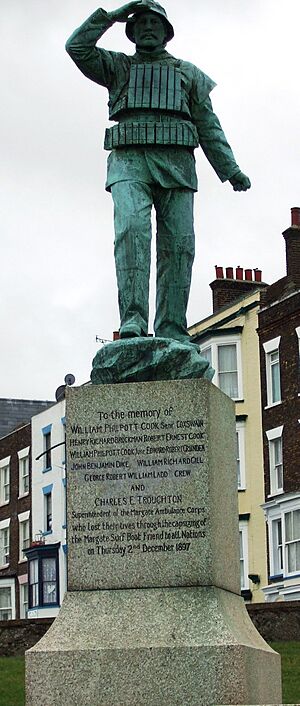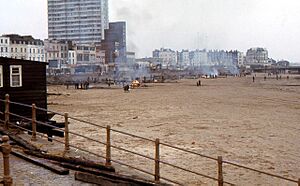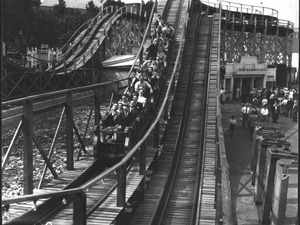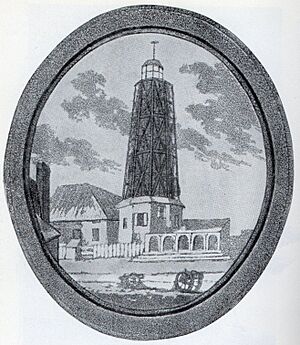History of Margate facts for kids
Margate is a historic town in England. It was once part of the "Cinque Ports," a group of important coastal towns. Margate joined this group in the 1400s.
Contents
- Margate and the Sea: A Popular Holiday Spot
- Steamboats: Bringing Visitors to Margate
- Railways: Connecting Margate to More People
- Royal School for Deaf Children: A Place of Learning
- Margate Jetty: A Pier's History
- Wherries: Pleasure Boats of Margate
- Margate During World War II
- Storm of 1949: Widespread Flooding
- Dreamland and the Scenic Railway: A Historic Amusement Park
- Windmills: Powering Margate's Past
Margate and the Sea: A Popular Holiday Spot
For over 250 years, Margate has been a top seaside resort. Like nearby Ramsgate and Broadstairs, it has always been a favorite holiday spot for people from London. They came to enjoy its beautiful sandy beaches.
In the 1700s, a writer named Edward Hasted called Margate a "poor fishing town." But by 1810, he described the shore as perfect for bathing. He wrote that the beach was "entirely level and covered with the finest sand." It stretched for miles on both sides of the harbor.
Hasted also mentioned the "bathing machines." These were special carts that took bathers into the sea. An umbrella-like canvas hid people from view as they stepped into the water. More than 40 of these machines were often used!
Margate's history is deeply connected to the sea. The town has a proud tradition of sailing and helping others at sea. Events like the story of the Friend to all Nations ship and the Margate Surfboat disaster of 1897 are important parts of its past.
Steamboats: Bringing Visitors to Margate
Around 1816, newspapers reported that new steamboats had given the Kent coast "a huge boost." This was especially true for the Isle of Thanet, where Margate is located.
However, not everyone was keen on them at first. Sir Rowland Hill, who later created the Penny Post, visited Thanet in 1815. He said, "It is surprising to see how most people are prejudiced against this packet."
Despite some early doubts, steamboat trips became very popular. By 1841, six different companies were competing to bring passengers to Margate. Even when railways arrived in 1846, steamboats continued to operate. They finally stopped running in 1967.
In 1820, people said that Margate's residents should thank James Watt. He was the inventor who helped develop the steam engine. They believed steam vessels were the "harbingers of their prosperity."
Railways: Connecting Margate to More People
The railway came to Margate thanks to two different companies. The South Eastern Railway (SER) was the first to arrive. Its line from Ashford reached Ramsgate on April 13, 1846. It then extended to a station called Margate Sands on December 1 of the same year.
This first route wasn't direct. Trains had to reverse from Ramsgate to get to Margate. Even so, many people started coming by train, adding to those already arriving by sea. The SER had the only railway to Margate for a while.
Then, on October 5, 1863, the London, Chatham and Dover Railway opened its own line. This company built a station called Margate West.
In 1923, the Southern Railway was formed. It reorganized the railways on the Isle of Thanet. The old route from Ramsgate was closed. A new railway loop around the island meant trains could now pass through Margate from either direction. Margate West (renamed simply Margate) became the town's only railway station. Today, the railway is run by Southeastern.
Royal School for Deaf Children: A Place of Learning
England's first public school for deaf children opened in London in 1792. It was called the 'London Asylum for the Education of the Deaf and Dumb Children of the Poor'.
This school opened a branch in Margate in August 1876. Later, the entire school moved from London to Margate. The school's Westgate College for Deaf People, for students aged 16 and over, closed on December 11, 2015.
Margate Jetty: A Pier's History
Margate Jetty, also known as Margate Pier, was designed by Eugenius Birch in 1856. Over the years, it faced damage from the sea.
On January 1, 1877, a storm-driven ship crashed into the pier. It cut the pier in half, leaving 40 to 50 people stranded. They were not rescued until the next day.
The pier survived until January 11–12, 1978. Another big storm hit it, and the pier's planks washed up onto Margate Beach. The broken parts of the pier stayed for several years. It even survived a few attempts to blow it up before it was finally removed.
Today, Margate Jetty is known as a "lost pier."
Wherries: Pleasure Boats of Margate
Between 1890 and 1939, about 30 pleasure boats operated from Margate beach. These boats were called Thanet wherries. The main builder was Brockman's of Margate, who made many of them before World War I.
They developed two main types of boats:
- The wherry proper, which had high sides.
- The wherry punt, which had low sides.
Traditionally, the hulls of these boats were varnished. Some boatmen made their wherries wider to help with fishing. The boats were built using a method called "clinker-built," where wooden planks overlap. Their shape was similar to boats from Deal and the Thames.
The last wherry used in Margate was operated by Dusty Miller. It was built in 1939 by an apprentice at Brockman's. It was only about 12 feet long and sometimes called a skiff because of its small size.
Margate During World War II
On September 3, 1940, at 9:50 AM, pilot officer Richard Hillary was shot down. He was fighting against three German Messerschmitt planes. He landed in the sea near the North Foreland and was rescued by the Margate lifeboat. His Spitfire plane had caught fire, and he was badly burned.
Hillary was the grandson of Sir William Hillary, who founded the lifeboat service. He recovered from his injuries and later wrote a book called The Last Enemy. Sadly, he died in a training flight accident in 1943, at just 24 years old.
During the Dunkirk evacuation in 1940, two brave lifeboat coxswains were honored. Howard Primrose Knight from the Ramsgate lifeboat and Edward Duke Parker from the Margate lifeboat were both awarded the Distinguished Service Medal. They showed great courage and determination while helping to ferry troops from the beaches of Dunkirk.
The lifeboats helped rescue at least 2,800 men. They towed eight wherries during a continuous service that lasted 40 hours. After this amazing effort, the Margate boat returned to Dunkirk. It rescued another 500–600 French soldiers from the beach.
The Commander of the HMS Icarus sent a letter to the RNLI (Royal National Lifeboat Institution). He wrote, "The way the Margate lifeboat crew brought off load after load of soldiers under continuous shelling, bombing and aerial machine-gun fire, will be an inspiration to us all as long as we live."
Storm of 1949: Widespread Flooding
A big storm in early March 1949 caused a lot of damage in Margate and along the North Kent Coast. The Kent Fire Brigade estimated that it took 1,550 hours of work to fight the floods. These floods had devastated Kent in the two weeks before the storm.
The high tide caused flooding in many places between Margate and Crayford. A huge tidal surge swept down the North Sea, into the Thames Estuary, and up the river valleys. It reached about 15 miles (24 km) inland. The flooding was so bad that Chatham, Rochester, Strood, Upnor, Gravesend, Sheerness, Sittingbourne, Faversham, Herne Bay, Whitstable, Dover, and Margate were all declared part of one major incident.
Dreamland and the Scenic Railway: A Historic Amusement Park
Dreamland amusement park was first opened in the 1920s. It is home to the oldest roller coaster in the UK, called the wooden Scenic Railway.
Dreamland and the Scenic Railway closed at the end of the 2006 season. But good news! They reopened in 2015 after the park was given a fresh new look and the Scenic Railway was fully restored.
Windmills: Powering Margate's Past
Margate has had several windmills over the centuries. They were important for grinding grain and other tasks.
Humber's (or Chamber's) Mill
This mill appeared on old maps from 1695, 1719, and 1736. It was located at Lydden, northeast of Fleete village.
Town Mill
The Town Mill was shown on a 1719 map and an 1858–72 map. It was known to be working in 1889.
Hooper's Mill
This was a unique horizontal windmill built by Stephen Hooper in the late 1700s. Its exact start date isn't known, but it was mentioned in a newspaper ad in March 1791. The mill was demolished around 1828. An old drawing shows it had forty vertical blades that turned a central shaft. It powered three pairs of millstones to grind grain.
Nayland Mill
This mill was on an 1801 map. It was later moved to the spot where Draper's Mill now stands. It would have been taken down in the 1840s.
Draper's Mill
Built in 1845 by John Holman, this smock mill used wind power until 1916. It then used an engine until the late 1930s. Luckily, it was saved from being demolished. Today, it is restored and open for people to visit.
Little Draper's Mill
This smock mill was moved from near Barham railway station in 1869. It was demolished in 1929, leaving only its base. The base itself was taken down in 1954.
Pumping Mill
This brick tower mill first appeared on an 1858-72 map. It was built with five sails. After a storm damaged it in 1878, it was rebuilt with four sails. Another storm hit it in August 1894. Repairs were too expensive, so they weren't done. The tower stood without its cap for a few years before being demolished in the early 1900s.







